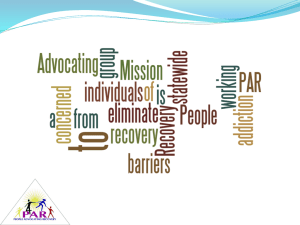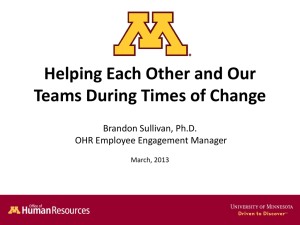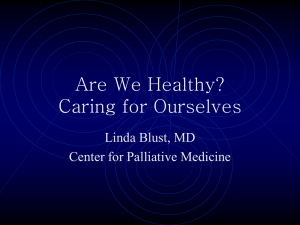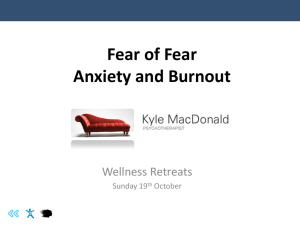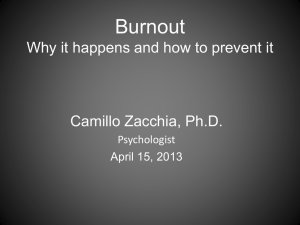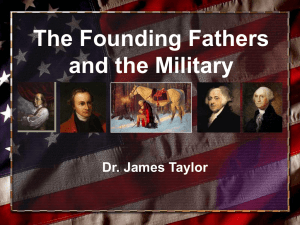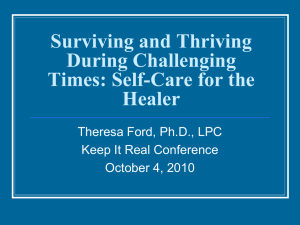Elizabeth`s Powerpoint Presentation
advertisement
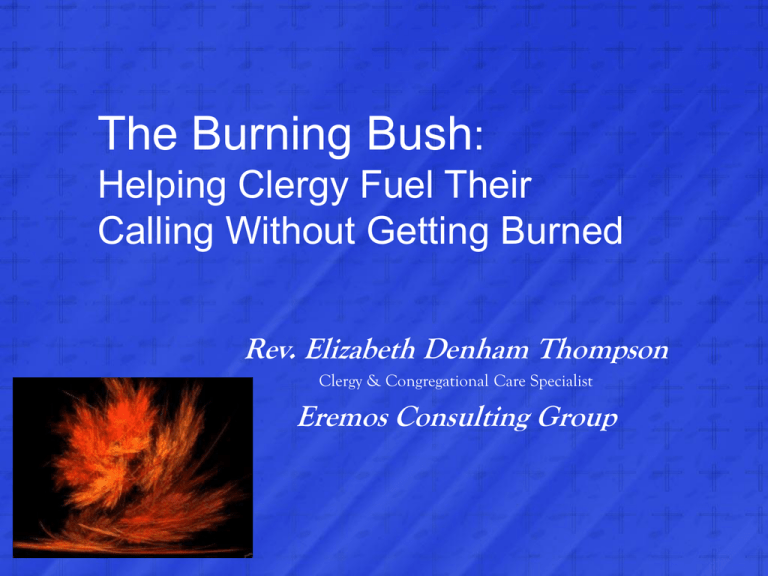
The Burning Bush: Helping Clergy Fuel Their Calling Without Getting Burned Rev. Elizabeth Denham Thompson Clergy & Congregational Care Specialist Eremos Consulting Group Clergy Burnout – Stories Clergy Burnout by the Numbers “Members of the Clergy now suffer from obesity, hypertension and depression at rates higher than most Americans. In the last decade, their use of antidepressants has risen, while their life expectancy has fallen. Many would change jobs if they could.” New York Times – August 2010 Clergy Burnout by the Numbers • • • • • • 13% of active pastors are divorced 23% have been fired or pressured to resign at least once in their careers. 25% don’t know where to turn when they have a family or personal conflict or issue. 33% felt burned out within their first five years of ministry. 40% of pastors and 47% of spouses are suffering from burnout, frantic schedules, and/or unrealistic expectations (from others as well as for others) 40% have no opportunity for outside renewal like a family vacation or continuing education. Clergy Burnout by the Numbers • • • • 45% of pastors say that they have experienced depression or burnout to the extent that they needed to take a leave of absence from ministry. 50% feel unable to meet the needs of the job and don’t believe the education they received gave adequate preparation for ministry. 56% of pastor’s wives say they have no close friends And 70% of pastors don’t have any close friends. Clergy Burnout by the Numbers • • • • 75% report severe stress causing anguish, worry, bewilderment, anger, depression, fear, and alienation. 75% of pastors in America, at any given time, want to quit (Church Resource Ministries 1998) 1500 pastors leave their ministries each month due to burnout, conflict, or moral failure. (some surveys show that it is as high as 2000 pastors) Doctors, lawyers and clergy have the most problems with drug abuse, alcoholism, and suicide. Clergy Burnout by the Numbers Past vs. Present In a 1991 study, pastors worked at least 46 hours a week. Recent surveys indicate that the work week is now at least 50 hrs/week, with another survey showing the average as 56.2 hrs/week - Up 4-10 hrs/week in the last 20 years. Other surveys show that 1 in 4 ministers work 60+ hours a week, and one survey had the average as 64-70 hrs/week Clergy Burnout by the Numbers Past vs. Present Two studies done in 1991 & 1992 showed • 28-33% of pastors believed ministry was a hazard to their family • 16% said it didn’t affect family either way • 57% thought it was beneficial. Two recent studies showed • 52% of pastors believe ministry is hazardous to their family’s well-being and health, and • 80% of pastors believe the ministry has negatively affected their families. Clergy Burnout by the Numbers Past vs. Present In 1992 the typical minister’s salary was increasing at less than ½ of the inflation rate. The median clergy salary was $32,000 a year including housing allowance, while the national average income for married couples was $40,000. The gap has widened. With current downturns in the economy (2008 & 2010), more ministers have had to let clergy associates and support staff go, and struggle to maintain salaries equal to the previous year. Often continuing education funding & discretionary spending accounts, etc. have been slashed. Clergy Burnout by the Numbers • 80% of clergy have a bachelor’s degree and half have a master’s degree, placing the Clergy among the most educated professions. • But they are among the lowest paid as well – nearly ¼ less than average American and an even more substantial drop compared to others with similar education credentials. • In one study, research found that four times as many ministers leave the profession during the first five years of ministry than did in the 1970’s. Clergy Burnout by the Numbers Duke’s Clergy Health Initiative Research is being conducted over a several year period – 2008, 2010, and 2012. Comparing results from surveys of North Carolina UMC clergy with surveys from the Centers for Disease Control and Prevention administered annually in every state, including NC. Purpose is to examine how to tailor interventions to clergy and their conditions. Results are showing that programs to improve clergy health will succeed only if they address the multiple conditions created by congregations and denominational politics, as well as by individuals. Clergy Burnout by the Numbers Duke’s Clergy Health Initiative Initial Findings – Obesity Rate? • 29% in NC General Population • 40% in UMC Clergy in NC These results mirror studies done by the Evangelical Lutheran Church in America (ELCA) in 2002, another done by the Presbyterian Church (USA), and a Pulpit & Pew national research project on ordained ministry in the US. Clergy Burnout by the Numbers Different Traditions There was a 1986 report in the Journal of Clinical Psychology of research with 250 religious professionals that included equal numbers of seminarians, Protestant ministers, and Roman Catholic priests, brothers, and sisters. Roman Catholic priests, brothers & sisters reported having less vocational strain and stronger supportive community than Protestant ministers. Clergy Burnout by the Numbers Different Traditions In another study of female clergy, nuns had less perceived pressure and stress and better coping resources than either female rabbis or Protestant clergywomen. The female rabbis reported the highest levels of stress. Protestant clergywomen the second highest, with Catholic sisters the lowest. A significant contributor for stress for rabbis and Protestant clergy is being a female in a predominantly male dominated profession. In contrast there is a long history of nuns in the Catholic system with their own places of power and authority. Clergy Burnout – Summary of the Numbers • First, clergy are lone rangers and going at their calling in the midst of deep loneliness and isolation. Few real friends. Little authentic community. • Second, clergy are tired. No, make that exhausted. That exhaustion is mental, physical and spiritual. They have overfunctioned or are depressed and thus “out of gas.” From Bill Wilson, president of the Center for Congregational Health November 10, 2011 Clergy Burnout – So Why Go Into Ordained Ministry? Clergy still rank high in job satisfaction, and life expectancy is still above average. Clergy don’t enter the field expecting to get rich, instead they want to make a difference in the world. Clergy Burnout – Moses and The Burning Bush • • • • • While tending the sheep of his father-in-law Jethro, priest of Midian, Moses led the flock along the west side of the wilderness and came to Horeb, the mountain of God. There an angel of the LORD appeared to him as a fire blazing out from a bush. Although the bush was on fire, it was not being burnt up, And Moses said to himself, ‘I must go across and see this remarkable sight. Why ever does the bush not burn away?’ When the LORD saw that Moses had turned aside to look, he called to him out of the bush, ‘Moses, Moses!’ He answered ‘Here I am!’ G-d said, ‘Do not come near! Take off your sandals for the place where you are standing is holy ground.’ Exodus 3:1-5 Clergy Burnout – Why Go Into Ordained Ministry? • sense of purpose and meaning, • feeling called by God to serve, • enjoyment and satisfaction from studying one’s faith, • teaching and preaching the faith, • witnessing and at times creating “holy & sacred moments”, • experiencing profound connections with others, • casting a vision for the mission and ministry of the congregation and the larger faith community, • practicing justice and embodying that 1:1 as well as in the larger community. Clergy Burnout – So what happens? All professionals have aspects of their job they don’t like. Same holds true for clergy. But clergy also have additional factors that contribute to burnout. Clergy Burnout – Definition #1 “Burnout is a state of physical, mental, spiritual and emotional exhaustion caused by extended and intense levels of stress, causing the body to overproduce adrenaline. It leads to the questioning of one’s abilities and/or the value of one’s work.” From www.pastorburnout.com Clergy Burnout – Definition #2 Burnout includes 1. Emotional Exhaustion, which can result in diminished interest in work, fatigue, and detachment. 2. Depersonalization, or the defensive distancing from the surrounding world, which can result in diminished contact with coworkers and the public, withdrawal of psychological investment, selfabsorption, and negative attitude toward others. 3. Dissatisfaction, or the perception of unsatisfactory personal accomplishment, which can result in feelings of failure, fatalism, diminished competence, and incapacity to respond to further environmental demands.” From www.stresshacker.com Clergy Burnout – Unique Career Challenges • Vulnerability of Care • Relationships are paramount • Conflict disrupts relationships • Minutiae overwhelms • Dual Relationships • Inability to “de-role” with congregants. • Place of employment is primary place of personal support. • Family dynamics at play. Clergy Burnout – Unique Career Challenges • 24/7Availability – • Immediate technology resources • Dealing with life crises that have no timetable • Overlapping of work hours for laity & clergy • Improper sense of boundaries related to work time, commitments, ability to say “no” or delegate. • Intrusion on family boundaries • Sheer volume of constant stress Clergy Burnout – Unique Career Challenges Trends affecting resources – • Aging of most congregations • Shrinking numbers in many congregations • Dwindling number of volunteers due to 2-income households • Most spouses of clergy have own career Some spouses & families resent the church as “other woman” in clergyperson’s life. Clergy Burnout – Unique Career Challenges • Additional Factors – • Mobility & Relocation Expectations • Generally lower pay, especially right out of seminary when school loans are highest • Congregational Conflict and Unhealthy System Dynamics • Ambiguous Job Description • Organizational & Religious Culture that rewards ‘workaholics’ and self-sacrifice Clergy Burnout – Causes of Stress • • • • • • • • • • • Administration Family Expectations Finances Conflicts Temptations/Escapes/Sin Self-Perception Theological & Spiritual Psychological Schedule Health Clergy Burnout – Why some do & others don’t … theories Professional Engagement Theory Proposes that the main cause of burnout is the imbalance between what individuals give to their job, and what they receive in return. Clergy Burnout – Why some do & others don’t … theories Motivational Model Theory – • Emotional fatigue can be explained by a perceived or actual lack of resources in individuals who can no longer control the stressors they must face. • “Negative Affect” as a personality trait has a pervasive and sustained influence on perceptions and behaviors. • Depersonalization and feelings of decreased achievement may be explained by the same process. Clergy Burnout – Why some do & others don’t … theories Stress and Motivation Model or Theory An alternative theory that the onset of burnout is produced by two factors: 1. the stress reaction, which is determined by professional requirements and inadequate resources; and 2. loss of motivation resulting from scarce resources and feelings of futility. Clergy Burnout – Why some do & others don’t … theories Internal Psychological Dynamics and Surrounding Social Expectations – Using Bowen’s concept of selfdifferentiation of self, this theory suggests that there is a direct correlation between the impact of differentiation of self, conflict management style, and longer experience in ministry to the increase or decrease of burnout. Clergy Burnout – Why some do & others don’t … theories This theory posits that clergy burn out because of the systems in which they work, combined with the high idealism that often accompanies clergy entering ministry. Burnout is the result of external systemic factors such as bureaucracy, poor administrative support, and difficult work conditions. And of intrapersonal factors such as high idealism, Type-A personalities, narcissism, and perfectionism. Clergy Burnout – What Can Be Done? From www.faithandleadership.com Clergy Burnout – What Can Be Done Clergy Intrapersonal & Interpersonal: • Personal Autonomy • Strong Social Support • Leadership Coaching • Psychotherapy • Medical Intervention • Healthy Lifestyle Choices • Setting Boundaries … “Just say NO” • Creating & Implementing a Personal Theology of Health Clergy Burnout – What Can Be Done Clergy Intrapersonal & Interpersonal • Liminality & Leadership • Let Go, Sit, & Think without agenda • Carve out time and space for the in-between. • Create a liminal “ethos of interaction” among key lay leaders & clergy • Casting a Vision Clergy Burnout – What Can Be Done Clergy Intrapersonal & Congregational • • • • • “Slow-Food Movement for the Clerical Soul” Take all the vacation entitled Observe Sabbath days (one day a week that is really off work; turn off cell phone!) Take Sabbaticals Take spiritual retreats Take retreats with spouses & family Clergy Burnout – What Can Be Done Congregational & Institutional: • Strong Organizational Support for Pastor • Build Healthy Congregation Systems • Help congregations understand Pastors’ roles and needs • Prepare congregations for and encourage lay leaders to set boundaries themselves. • Train lay leaders to hold pastors accountable for taking time away, and to educate the congregation • Shared Ministry concept Clergy Burnout – Moses and The Burning Bush • While tending the sheep of his father-in-law Jethro, priest of Midian, Moses led the flock along the west side of the wilderness and came to Horeb, the mountain of God. • There an angel of the LORD appeared to him as a fire blazing out from a bush. Although the bush was on fire, it was not being burnt up, • And Moses said to himself, ‘I must go across and see this remarkable sight. Why ever does the bush not burn away?’ • When the LORD saw that Moses had turned aside to look, he called to him out of the bush, ‘Moses, Moses!’ He answered ‘Here I am!’ • G-d said, ‘Do not come near! Take off your sandals for the place where you are standing is holy ground.’ Exodus 3:1-5 Clergy Burnout – Story of Hope Struggling out of the Valley of Shadows Edgar Moore Clergy Burnout – Questions to Consider • How does your theology inform your health practices? What does it mean to embody your faith? • Have particular aspects of your denomination’s polity affected your health? • Have institutional factors contributed to your well-being, or undermined it? • Are there denominational, corporate, and/or organizational changes that might improve clergy health? • Who has been particularly supportive of you during your ministry? Clergy Burnout – Questions to Consider • How might we engage congregations around health issues, from the foods we serve to the ways we advocate for health in our communities? • How could the topic of “clergy health” be broadened into a conversation about laity and clergy roles in the shared ministry of the congregation? • Do you think the way ministry is practiced in the 21st century contributes to poor health? Why or why not? • If you could propose ways to make clergy healthier, what would you suggest? Rev. Elizabeth Denham Thompson, LMFT, AAPC Fellow Eremos Consulting Group 303-902-7805 ethompson@EremosConsulting.com www.EremosConsulting.com


